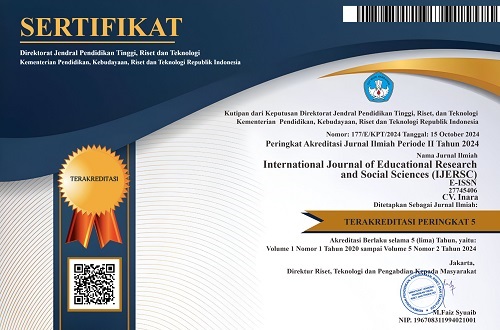The Practice Of Prayer As An Application Of Islamic Religious Education To The Fisherman Community On Harapan Island
DOI:
https://doi.org/10.51601/ijersc.v5i4.854Abstract
The main problem in this study is "The Practice of the Fisherman Community of Harapan Island regarding Prayer Worship". Then it is described into three sub-discussions, namely. The practice of the fishermen of the island of Harapan regarding prayer. The aim is to determine the level of worship of the fishermen community on Harapan Island. Approachused are Academic-Subjects, and Social Reconstruction. After that, conduct observations, interviews and documentation to obtain information and data in the field. Furthermore, the data obtained was selected as well as reducing what is considered unnecessary, then performs presentation and verification to test the validity of the existing data. The results of this study revealed that theoretically, the people of Harapan Island were not very proficient in explaining the meanings of worshipprayer. Pratically, it is inversely proportional to the knowledge expressed through meaning during interviews with researchers. They were a religious society, always trying to fulfill all the obligations that Allah has commanded. This is proven when they go to sea, they continue to fulfill their prayer obligations and even bring prayer equipment with them. In terms of education through prayer worship, it is by giving an example first, then informing the family of the benefits (religious, health and social) when carrying out the obligations, especially the prayer worship. Furthermore, advise family members if they do not fulfill it and provide training according to their abilities. This study has limitations on the cases observed in Fisherman Community of Harapan Island. The findings of this research provide an overview of the level of prayer implementation among the Harapan Island fishing community when going to sea.
Downloads
References
P. Yanasari, “Pendekatan Antropologi dalam Penelitian Agama bagi Sosial Worker,” Empower J. Pengemb. Masy. Islam, vol. 4, no. 2, pp. 225–240, 2019.
A. Primastuti, “Coastal Community Empowerment: Methods, Challenges, and Solutions,” Int. J. Kybernology, vol. 3, no. 1, pp. 39–55, 2016.
A. Rahman and A. Mutakabbir, “The Practice Of Zakat Worship As An Application Of Islamic Religious Education To The Fisherman Community Of Harapan Island In Jeneponto Regency, South Sulawesi,” Int. J. Educ. Res. Soc. Sci., vol. 4, no. 6, pp. 969–978, 2023, doi: 10.51601/ijersc.v4i6.750.
M. R. Abdulla, “Culture, Religion, and Freedom of Religion or Belief,” Rev. Faith Int. Aff., vol. 16, no. 4, pp. 102–115, 2018, doi: 10.1080/15570274.2018.1535033.
H. K. Abdul Malik Iskandar, Jalal, “Analisis Nilai-Nilai Pendidikan Karakter Dalam Film ‘Sepatu Dahlan’ Karya Benni Setiawan dan Manfaatnya Dalam Pembelajaran Sosiologi di SMA,” EDULEC Educ. Lang. Cult. J., vol. 3, no. 3, pp. 318–328, 2023, doi: https://doi.org/10.56314/edulec.v3i3.
W. J. Wainwright, Religion and Morality. London: Routledge, 2017. doi: https://doi.org/10.4324/9781315244778.
H. K. Arfenti Amir, Akhiruddin, Gusti Rani, “Peran Guru Dalam Membangun Karakter Siswa Kelas X IPS 1 di SMA Nasional Makassar,” EDULEC Educ. Lang. Cult. J., vol. 4, no. 1, pp. 64–73, 2024, doi: https://doi.org/10.56314/edulec.v4i1.215.
A. D. Makrufi et al., “MULTICULTURAL ISLAMIC EDUCATION LEARNING SYSTEM IMPLEMENTATION IN THE DIGITAL ERA,” J. Hunafa Stud. Islam., vol. 18, no. 2, pp. 215–241, 2021.
T. Hidayati and W. Kurniawan, “Stability Analysis of Lotka-Volterra Model in The Case of Interaction of Local Religion and Official Religion,” Int. J. Educ. Res. &Amp; Soc. Sci., vol. 2, no. 3, pp. 542–546, 2016, doi: https://doi.org/10.51601/ijersc.v2i3.97.
M. H. Zubaidillah, “Concept Of Islamic Education In The Qur’an,” OSF Prepr., no. Juli, pp. 1–13, 2018.
M. Huda, “Life Long Education in Islamic Perspective,” Int. J. Nusant. Islam, vol. 07, no. 01, pp. 40–48, 2019, doi: http://dx.doi.org/10.15575/ijni.v7i1.4006.
M. Muchtarom, “Islamic Education in the Context of Indonesia National Education,” J. Pendidik. Islam, vol. 28, no. 2, p. 323, 2016, doi: 10.15575/jpi.v28i2.551.
F. Mansir, “The Position of Islamic Education According to the National Educational System in Indonesia,” Progres. J. Pemikir. dan Pendidik. Islam, vol. 11, no. 01, pp. 43–54, 2022, doi: 10.22219/progresiva.v11i01.20416.
B. T. Ari Nugroho, “Integration of Islamic education with science and technology in Islamic junior high school,” MUDARRISA J. Kaji. Pendidik. Islam, vol. 9, no. 1, pp. 1–27, 2017, doi: 10.18326/mdr.v9i1.1-27.
A. Day, Religion and the individual: Belief, practice, identity. London: Routledge, 2016.
H. Hasyim, “Supporters of football and social movements: An examination of resource mobilization among fans of the PSM club in South Sulawesi,” Retos, vol. 52, pp. 232–239, 2023, doi: https://doi.org/10.47197/retos.v52.102214.
Islam, M. K., Haque, M. R., & Hossain, M. B. (2016). Regional variations in child marriage in Bangladesh. Journal of Biosocial Science, 48(5), 694-708.
Kabeer, N. (2016). Gender equality, economic growth, and women’s agency: the “endless variety” and “monotonous similarity” of patriarchal constraints. Feminist Economics, 22(1), 295-321.
Kabir, M. R., Ghosh, S., & Shawly, A. (2019). Causes of early marriage and its effect on reproductive health of young mothers in Bangladesh. American Journal of Applied Sciences, 16(9), 289-297.
Kalamar, A. M., Lee-Rife, S., & Hindin, M. J. (2016). Interventions to prevent child marriage among young people in low-and middle-income countries: a systematic review of the published and gray literature. Journal of Adolescent Health, 59(3), S16-S21.
Karoui, K., & Feki, R. (2018). The effect of gender inequality on economic development: Case of African countries. Journal of the Knowledge Economy, 9(1), 294-300.
Klasen, S., & Lamanna, F. (2009). The impact of gender inequality in education and employment on economic growth: new evidence for a panel of countries. Feminist Economics, 15(3), 91-132.
Kohno, A., Techasrivichien, T., Suguimoto, S. P., Dahlui, M., Nik Farid, N. D., & Nakayama, T. (2020). Investigation of the key factors that influence the girls to enter into child marriage: A meta-synthesis of qualitative evidence. PLoS One, 15(7), e0235959.
Kyari, G. V., & Ayodele, J. (2014). The socio-economic effect of early marriage in North Western Nigeria. Mediterranean Journal of Social Sciences, 5(14), 582-582.
Lincoln, Y. S., & Guba, E. G. (1985). Naturalistic inquiry: sage.
Downloads
Published
How to Cite
Issue
Section
License
Copyright (c) 2024 International Journal of Educational Research & Social Sciences

This work is licensed under a Creative Commons Attribution 4.0 International License.






















